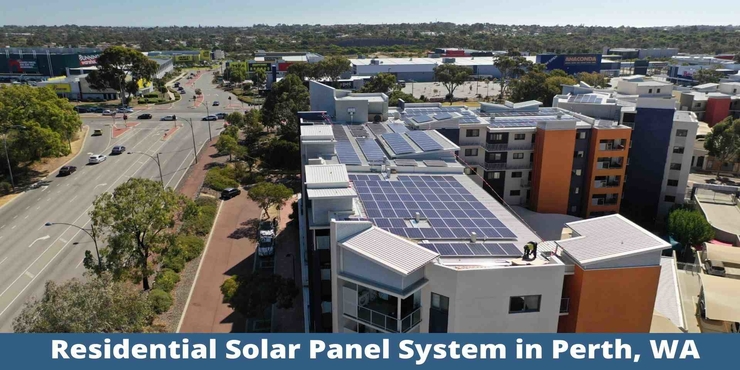Solar Power Systems:- Solar cells (also known as Photovoltaic or PV cells) convert the sun’s energy into usable energy. These cells are made up of semiconductor material similar to those found in computer chips.
For individual homes, residential solar power systems are used to harness the energy and convert it into electricity, however, the size and the amount of the power generation is relatively small when we talk of residential solar power systems. Residential solar panels in Australia are typically installed on rooftops of homes or in open land (ground-mounted) and is generally between 5 and 20 KW depending upon the size of the property.
Residential Solar Power/ Panel Systems Installation & Repair In Perth, WA
Their residential solar power systems can be broadly classified into three main types i.e grid-connected systems, off-grid systems and hybrid systems.
Grid- Connected Solar Power Systems
Though it’s absolutely possible to run independently of an energy grid connection, doing so permits you to bypass the costs incurred in power storage by allowing you to feed unused solar power at once into the power grid. With this technique, you use natural resources while they are available and use the traditionally available power from the grid for the remainder of your electricity needs. A grid-connected residential solar power system installation is the most commonly used device in Australia.
Fig 1: Grid- Connected Solar Panel System
Off- Grid Solar PV Systems
Independent Solar systems are fairly useful in regions with confined utilities. Using a totally off-grid solar system requires a few extra types of equipment within the way of batteries and/or other energy storage devices, however, the end result is complete independence from any other source of energy. In certain places, there are also regulations that dictate what residences and groups need to be tied into a grid. Going off-grid approach means absolute freedom, but if that is the course you’re taking, it’s best to use some heavy-duty long-lasting energy storage devices and best quality solar panels.
Fig 2: Off-Grid Solar Panel Systems
Hybrid Solar PV Systems
The hybrid system uses traditional utility power as a source of backup only which means the power supply from the grid will only be used in extreme cases when all the stored solar power has been exhausted, such as in the days of very limited sun availability.
Different Sizes of Residential Solar Panels in Australia
| Physical Size | |
| Length and width | 65 inches X 39 inches |
| Depth | 1.4 inches to 1.8 inches |
| Weight | 40 pounds |
| Number of solar cells | 60 |
| Power rating or wattage | 230 to 275 watts DC STC |
Residential Solar Photovoltaic Systems Size and Price Comparison List In Perth, WA
The table below shows the prices for different solar system sizes for different regions of Australia. With the increasing popularity and introduction of new technologies in PV panel manufacturing techniques, the prices have drastically decreased over the years.
| 1.5KW | 3KW | 4KW | 5KW | 6KW | 7KW | 10KW | |
| ADELAIDE, SA | $2,530 | $3,230 | $3,740 | $4,100 | $4,520 | $5,630 | $8,330 |
| BRISBANE, QLD | $3,050 | $3,870 | $4,520 | $5,110 | $5,430 | $7,090 | $9,660 |
| CANBERRA, ACT | $2,930 | $3,820 | $4,520 | $4,420 | $4,840 | $6,150 | $8,260 |
| DARWIN, NT | $4,860 | $6,950 | $7,930 | $9,510 | $9,980 | $10,990 | $12,060 |
| HOBART, TAS | $3,040 | $3,980 | $4,970 | $5,500 | $6,640 | $8,260 | $11,340 |
| MELBOURNE, VIC | $2,940 | $3,730 | $4,350 | $4,830 | $5,400 | $7,210 | $9,950 |
| SYDNEY, NSW | $3,100 | $3,630 | $4,120 | $4,510 | $4,980 | $6,580 | $8,760 |
| PERTH, WA | $2,460 | $2,550 | $3,190 | $3,120 | $4,200 | $5,420 | $9,100 |
Residential Solar Panel Buying Guide For Perth, WA
Considerations of daily power consumption are required to be assessed before selecting the right system. Some of the important things that need to be taken into account while selecting the solar system for a residence are listed below:
- Assess how much amount of energy you currently consume and based on that you can select the system capacity you need (and can afford).
- Check the direction of your roof faces. Only north-facing panels will produce their full capacity.
- Ensure there aren’t any trees, electricity lines or different structures shading your roof.
- Find out what local council approval is needed. Increasingly, local councils have staff on hand to help people make the best decisions on solar.
- The inverter (which converts DC power from the panels into AC power for your home) is a key part of the system. Compare the inverter available in the market from different manufacturers and choose the right one as per your need.
- Check your solar panels’ product and performance warranties.
A table to understand the cost of the different residential solar power system in Australia:
| Size | No. of Panels | Cost | Power Generation |
| 1.5KW | 5 | $3,200 | 7 units/day |
| 2kW | 6 | $2,690 to $3,990 | 9 units/day |
| 3kW | 10 | $2,990 to $5,490 | 13 units/day |
| 4kW | 13 | $3,660 to $6,900 | 18 units/day |
| 5kW | 17 | $3,990 to $8,000 | 22 units/day |
| 6kW | 20 | $3,990 to $9,000 | 26 units/day |
| 7kW | 23 | $7,300 to $10,900 | 31 units/day |
| 8kW | 27 | $7,500 and $11,200 | 35 units/day |
| 9kW | 30 | $9,600 to $13,600 | 40 units/day |
| 10kW | 33 | $9,900 and $14,300 | 44 units/day |
| 15kW | 50 | $14,900 | 60 units/day |
Residential Solar Power System Installations, Standards and Warranties In Perth, WA
There are certain Australian standards that apply when it comes to the installation of solar panels. The solar installer you have chosen to do the work needs to follow a wide range of rules and regulations. Australian Standards that apply include:
*AS/NZS 5033 Installation of photovoltaic (PV) arrays
* AS/NZS 3000 Electrical Wiring Rules
* AS 1768 Lightning Protection
* AS/NZS 1170.2 Wind Loads
* AS4777 Grid Connections of Energy Systems via Inverters
* AS 4509 Stand-alone power systems
. part 1 Safety requirements
. part 2 Design guidelines
. part 3 Installation and maintenance
Warranties
Solar installations generally come with two types of warranties namely product and performance warranty.
a) Product warranty
It is very important to differentiate between product and performance warranty because people often confuse between both as the performance warranty which is usually 25 years as compared to only 10 years of product warranty is promoted more loudly but it’s the product warranty that will save you extra dollars and is the one that you would likely to call if there is any problem.
b) Performance warranty
The performance warranty is a guarantee that as long as the panel is functioning and undamaged, it will still produce at least 80% of its claimed power rating after 25 years. The warranty usually also promises that the panel will degrade in an orderly, linear fashion; that is, it will only lose a small and predictable amount of power output each year.
c) Other warranties
As well as the warranties for the solar energy panels, you should also get a warranty from the installer for their workmanship in installing the system; the mounting racks, wiring and connections.
Frequently Asked Questions for Residential Solar Power System
1. How Much Money Will I Save Using Solar Power In Perth, WA?
Payback times vary depending on where you live in Australia. The infographic below shows averages for the average time taken by capital cities for a 5 KW system to pay for itself in capital cities of Australia.
2. What is the Average Cost of Residential Solar PV System In Perth, WA?
However, a good quality 3kW system in Australia will cost between $5,000 – $8,000 due to differences in quality and the fact that panels only make up a partial amount of the total cost of your solar PV system. Additional residential power system costs include mounting system, residential solar panel repair, balance and installation etc.
3. What is the Difference Between Residential and Commercial Solar Power Systems?
There may be a lot of differences when it comes to differentiating between residential and commercial solar power systems, but the major two are listed below:
- They are Different Sizes
The average size of a commercial solar panel is 96 cells, while the average size of a residential panel is 72. - Commercial Systems Are Easier To Install and Have More Options
Commercial solar systems are often installed on flat roofs, meaning they can use a mounting system that doesn’t penetrate the roof and is much simpler to set up. Companies can install solar panel systems on their roofs just like residential buildings, but they can also expand more creatively. Solar panelled parking lots are another choice, as are ground installations in the surrounding land.
4. Which Direction Should My Solar Panel Face in Perth, WA?
The direction of solar panel should be such that it faces towards maximum sun exposure depending upon the location. For Australia, the best direction that yields maximum output is NORTH. However, even if the panels are not facing north due to the location of the property and other factors, you can still get good output.
5. What Size Residential Solar Panel System Do I Need for My Home In Perth, WA?
States and territories give automatic approval to rooftop solar power panels systems that comply with the Australian standard for solar installation:
5 kW or under. In most states and territories, there is automatic approval given to any solar system up to 5 kW. However, this is not set in stone.
5. Does My Residential Solar Panel System Meet Standards in Perth, Western Australia?
Having a solar mounting frame and roof panel too close to the edge of the roof will increase significantly the wind forces on the panel and system structure during heavy winds. Compliance with the standards requires your installer to verify and sign off that your roof construction integrity has not been compromised by using the new solar power system.




